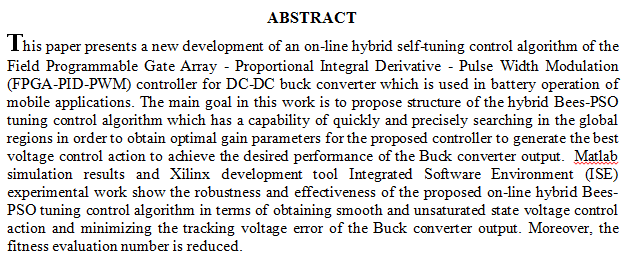
A specific, sensitive and new simple method was used for the determination of methyldopa in pure and pharmaceutical formulations by using continuous flow injection analysis. This method is based on formation of ion pair compound between methyldopa and potassium hexacyanoferrate in acidic medium to obtain a yellow precipitate complex using long distance chasing photometer (NAG-ADF-300-2). The linear range for calibration graph was 0.05-35 mmol/L for cell A and 0.05-25 mmol/L for cell B, and LOD 1.4292 µg /200 µL for both cells with correlation coefficient (r) 0.9981 for cell A and 0.9994 for cell B, RSD% was lower than 0.5 % for n=8 for. The results were compared with classical method UV-Spectrophotometric at λ max=280 nm and turbi
... Show More (1)
(1)
 (2)
(2)
Abstract
The purpose of our study was to develop Dabigatran Etexilate loaded nanostructured lipid carriers (DE-NLCs) using Glyceryl monostearate and Oleic acid as lipid matrix, and to estimate the potential of the developed delivery system to improve oral absorption of low bioavailability drug, different Oleic acid ratios effect on particle size, zeta potential, entrapment efficiency and loading capacity were studied, the optimized DE-NLCs shows a particle size within the nanorange, the zeta potential (ZP) was 33.81±0.73mV with drug entrapment efficiency (EE%) of 92.42±2.31% and a loading capacity (DL%) of 7.69±0.17%. about 92% of drug was released in 24hr in a controlled manner, the ex-vivo intestinal p
... Show More (8)
(8)
 (3)
(3)
In the present study, magnet silica-coated Ag2WO4/Ag2S nanocomposites (FOSOAWAS) were fabricated via a multistep method to address the drawbacks related to single photocatalysts (pure Ag2WO4 and pure Ag2S) and to clarify the significant influence of semiconductor heterojunction on the enhancement of visible-light-driven organic degradation. Different techniques were performed to investigate the elemental composition, morphology, magnetic and photoelectrochemical properties of the fabricated FOSOAWAS photocatalyst. The FOSOAWAS photocatalyst (1 g/L) exhibited excellent photodegradation efficiency (99.5%) against Congo red dye (CR = 20 ppm) after 140 min of visible-light illumination. This result confirmed the ability of the heterojunction be
... Show More (64)
(64)
New chalcones of -{ - - - y - - hi di z e- -y he y - - e e- - e- - - substituted phenyl have been prepared from condensation of a new of 4-[5-(4`-tolyl)1,3,4-thiadiazole-2-yl] benzaldehyde (which is synthesized by the reaction of 2- amino-5- (4`-tolyl) -1,3,4-thiadiazole and benzaldehyde) with 3- or 4- substituted acetophenones in alkaline medium. The physical, CHNS analysis and spectral data of the synthesized compounds were determined. The biological activity evaluated of new compounds showed that many of these compounds possess antiba
... Show More (5)
(5)
The study involved preparing a new compound by combining Schiff bases generated from compounds for antipyrine, including lanthanide ions (lanthanum, neodymium, erbium, gadolinium, and dysprosium). The preparation of the ligand from condensation reactions (4-antipyrinecarboxaldehyde with ethylene di-amine) at room temperature, and was characterization using spectroscopic and analytical studies ( FT-IR, UV-visible spectra, 1H-NMR, mass spectrometry, (C.H.N.O), thermogravimetric analysis (TGA), in addition to the magnetic susceptibility and conductivity measurement of the synthesis complexes, among the results we obtained from the tests, we showed that the ligand behaves with the (triple Valence) lanthanide ions, the multidentate
... Show More (7)
(7)
 (2)
(2)
Activated carbon prepared from date stones by chemical activation with ferric chloride (FAC) was used an adsorbent to remove phenolic compounds such as phenol (Ph) and p-nitro phenol (PNPh) from aqueous solutions. The influence of process variables represented by solution pH value (2-12), adsorbent to adsorbate weight ratio (0.2-1.8), and contact time (30-150 min) on removal percentage and adsorbed amount of Ph and PNPh onto FAC was studied. For PNPh adsorption,( 97.43 %) maximum removal percentage and (48.71 mg/g) adsorbed amount was achieved at (5) solution pH,( 1) adsorbent to adsorbate weight ratio, and (90 min) contact time. While for Ph adsorption, at (4) solution pH, (1.4) absorbent to adsorbate weight ratio, and (120 min) contact
... Show More (3)
(3)
A multistep synthesis was established for the preparation of a new vanillic acid-1, 2, 4-1triazole-3-thiol conjugate (
 (1)
(1)
 (1)
(1)
Background: Suppression of quorum sensing (QS) that regulates many virulence factors, including antimicrobial resistance, in bacteria may subject the pathogenic microbes to the harmful consequences of the antibiotics, increasing their susceptibility to such drugs. Aim: The current study aimed to make an aqueous crude extract from the soil Proteus mirabilis isolate with the use of the gas chromatography-mass spectrometry (GC-MS) technique for its analysis, and then, study the impact of the extract on clinical isolates of Pseudomonas aeruginosa. Methods: Preparation of crude extracts from P. mirabilis (both organic and aqueous), which were then analyzed by GC-MS to detect the bioactive ingredients. Furthermore, the extract’s capability to i
... Show MoreCombining different treatment strategies successively or simultaneously has become recommended to achieve high purification standards for the treated discharged water. The current work focused on combining electrocoagulation, ion-exchange, and ultrasonication treatment approaches for the simultaneous removal of copper, nickel, and zinc ions from water. The removal of the three studied ions was significantly enhanced by increasing the power density (4–10 mA/cm2) and NaCl salt concentration (0.5–1.5 g/L) at a natural solution pH. The simultaneous removal of these metal ions at 4 mA/cm2 and 1 g NaCl/L was highly improved by introducing 1 g/L of mordenite zeolite as an ion-exchanger. A remarkable removal of heavy metals was reported
... Show MoreThis investigation reports application of a mesoporous nanomaterial based on dicationic ionic liquid bonded to amorphous silica, namely nano-N,N,N′,N′-tetramethyl-N-(silican-propyl)-N′-sulfo-ethane-1,2-diaminium chloride (nano-[TSPSED][Cl]2), as an extremely effectual and recoverable catalyst for the generation of bis(pyrazolyl)methanes and pyrazolopyranopyrimidines in solvent-free conditions. In both synthetic protocols, the performance of this catalyst was very useful and general and presented attractive features including short reaction times with high yields, reasonable turnover frequency and turnover number values, easy workup, high performance under mild conditions, recoverability and reusability in 5 consecutive runs without lo
... Show More